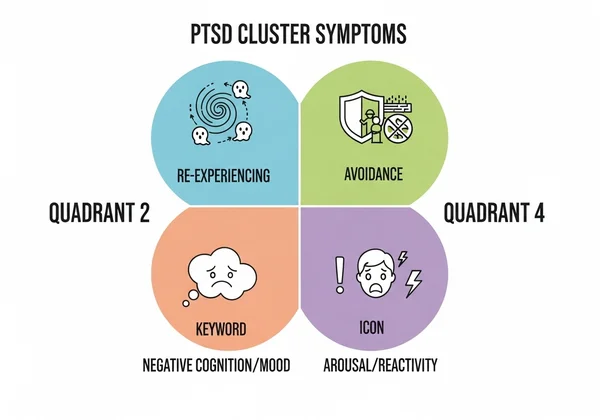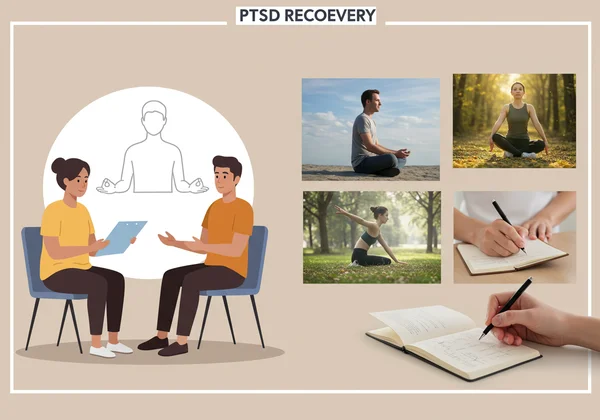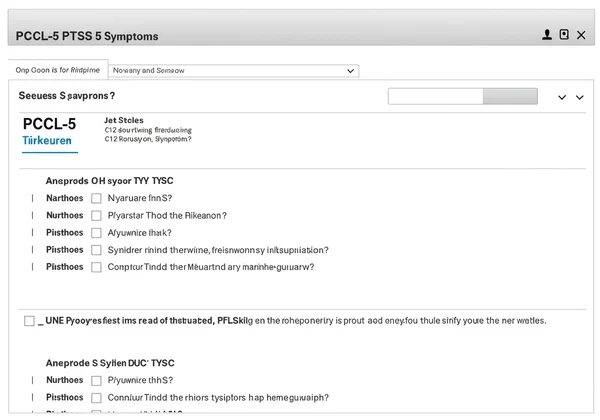PCL5 创伤后应激障碍症状测试:了解症状、原因、类型与康复
创伤会留下无形的印记,在事件发生很久之后,仍然会重塑我们看待世界和与世界互动的方式。对数百万人来说,这种挥之不去的影响表现为创伤后应激障碍 (PTSD),这是一种经常被误解的疾病。如果你曾觉得过去的经历仍然对你的现在有影响力,你并不孤单。 什么是 PTSD,它在日常生活中如何表现?这份综合指南将带你了解其核心症状、常见原因、不同类型以及充满希望的康复之路。理解是迈向治愈的第一步,获得清晰的认识可以让你更有力量地前行。如需初步保密地了解你的个人经历,你可以 参加我们的 PCL-5 测试。

了解 PTSD:定义与演变
创伤后应激障碍是一种精神健康状况,可能发生在经历或目睹过可怕创伤事件的个体身上。虽然在这些情况下感到恐惧是正常的人类反应,但患有 PTSD 的人即使在不再危险时,仍会感到压力或惊恐。本节将阐述诊断的基础知识。
PTSD 代表什么?(创伤后应激障碍)
PTSD 代表创伤后应激障碍。它精确地描述了这种状况:一种在“创伤性”事件之后(“后”)出现的,以强烈心理“应激”为特征的“障碍”。这是一种公认且可治疗的医学疾病,而非个人软弱的标志。
PTSD 识别简史
创伤持久影响的概念并非新鲜事。几个世纪以来,人们在士兵身上观察到这种现象,在第一次世界大战中被称为“炮弹休克”,在第二次世界大战中被称为“战斗疲劳”。然而,直到 1980 年,PTSD 才被正式认定 为美国精神病学协会《精神疾病诊断与统计手册》(DSM) 中的一个独立诊断,承认其影响远远超出了军事战斗。
核心诊断标准与 PCL5:DSM-5 概述
如今,PTSD 的诊断遵循 DSM-5 中概述的标准,这是精神卫生专业人员使用的精神疾病标准分类。这些标准将症状分为四个主要类别,为理解该疾病提供了结构化框架。同样的框架也是 PCL-5 评估等可靠筛查工具的基础。
识别 PTSD 症状:四大核心类别
了解 PTSD 症状 是识别自己或他人状况的关键。根据 DSM-5,这些症状分为四个不同的类别或“集群”。一个人必须在所有四个类别中经历症状超过一个月,才会被考虑诊断为 PTSD。

再体验症状:侵入性记忆和闪回
这一类别涉及非自愿地重温创伤事件。这不仅仅是回忆;这是一种强烈的、通常是感官丰富的再体验。症状包括 侵入性记忆、关于事件的痛苦梦境或噩梦,以及闪回,让你感觉创伤正在再次发生。
回避症状:远离提醒物
患有 PTSD 的人可能会不遗余力地避免创伤的提醒物。这可能意味着 避免接触人、地点、对话或引发痛苦记忆的活动。它也可能表现为避免与事件相关的想法或感受,这可能导致情感麻木和疏离感。
认知与情绪的负面改变:思想和感受的变化
创伤可以从根本上改变你对自我和世界的看法。这一类别包括对创伤原因或后果的持久且扭曲的信念,导致自我责备。其他症状包括 持续的负面情绪,如恐惧、愤怒、内疚或羞耻,对以前喜欢的活动兴趣减退,以及感到与他人疏远。
警觉性与反应性的改变:过度警觉和易怒
这一类别与持续处于高度警觉状态有关。症状包括 过度警觉(感觉持续“戒备”)、容易受惊、睡眠困难以及经历愤怒爆发或易怒行为。这种高度警觉的状态可能导致身心俱疲。如果这些类别与你产生共鸣,PCL-5 评估可以帮助你将这些感受整理成更清晰的画面。通过保密测试了解你的症状。
PTSD 的 20 种症状(根据 PCL5 清单)
基于 DSM-5 标准的 PCL-5 清单,概述了这四个类别中的 20 种具体症状。这些问题旨在系统地测量每种潜在症状的严重程度,全面概述创伤可能如何影响你。
是什么导致 PTSD?了解诱因和风险因素
尽管创伤是催化剂,但具体 是什么导致 PTSD 则更为复杂。并非所有经历创伤事件的人都会发展出这种疾病。事件的性质、个体风险因素和事件后的支持系统共同发挥着重要作用。
![]()
导致 PTSD 的常见创伤事件
各种各样的事件都可能具有足够的创伤性,导致 PTSD。这些事件不限于战斗,可能发生在任何人身上。常见例子包括经历或目睹严重事故、身体或性侵犯、自然灾害、恐怖袭击、童年虐待或危及生命的医疗诊断。
谁最容易患上 PTSD?
某些因素会增加一个人在创伤事件后患上 PTSD 的脆弱性。这些 风险因素 包括有焦虑症或抑郁症等其他精神健康问题的病史,缺乏强大的亲友支持系统,经历长期或强烈的创伤,或从事增加创伤事件暴露风险的工作,例如作为急救人员。
为什么有些人会患上 PTSD 而另一些人不会?
韧性是一个关键因素。个体的应对机制、基因、原有信念以及事件后立即获得的支持都可能影响结果。两个人可能经历相同的事件,但他们独特的生物和心理构成将塑造他们的反应,决定为什么一个人可能发展出 PTSD 而另一个人不会。
探索不同类型的 PTSD
PTSD 对每个人来说并不总是相同的。创伤的性质和症状发作的时间可能导致疾病的不同表现。了解这些变异对于认识创伤后应激的完整范围至关重要。
经典 PTSD 与复杂性 PTSD (C-PTSD)
经典 PTSD 通常由单一、明确的创伤事件引起。 复杂性 PTSD (C-PTSD) 虽然尚未被 DSM-5 正式诊断,但它是一个术语,用于描述由长期、重复性创伤(如持续的家庭暴力或童年虐待)引起的严重形式的 PTSD。C-PTSD 通常包括额外的症状,如情绪调节、意识和自我认知方面的困难。
延迟发作型 PTSD 及其他表现形式
有时,PTSD 症状直到创伤事件发生数月甚至数年后才会出现。这被称为 延迟发作型 PTSD。症状可能由后来的生活事件、新的压力源或对原始创伤的提醒触发。认识到症状可能在很久之后才出现,对于准确理解和提供支持至关重要。
康复之路:有效的 PCL5 引导的 PTSD 治疗与应对
PTSD 的诊断并非终身判决。康复是可能的,有许多有效的治疗和策略可以帮助管理症状并重拾生活。旅程始于寻求帮助和学习应对。

PTSD 的专业疗法(CBT、EMDR 等)
基于证据的疗法是 PTSD 康复 的基石。创伤焦点认知行为疗法 (TF-CBT) 等治疗帮助个体处理创伤记忆并改变负面思维模式。眼动脱敏与再加工疗法 (EMDR) 是另一种高效疗法,它利用双边刺激帮助大脑重新处理创伤记忆。
管理症状的自我护理和应对机制
除了专业治疗,自我护理策略 也至关重要。落地技巧可以帮助即时管理闪回和焦虑。正念、冥想、规律运动和保持健康的睡眠习惯等做法可以显著减少警觉症状,并改善整体情绪和韧性。
寻求支持和建立网络的重要性
从创伤中恢复不应该是一段孤独的旅程。与值得信赖的朋友、家人或支持团体建立联系,可以提供社区感并减少孤立感。与理解你的人分享你的经历会带来巨大的认同感,是康复的重要组成部分。一个很好的第一步是使用 免费在线 PCL-5 获取你症状的保密、私人基线。
迈出下一步:你的治愈之旅
应对创伤的后果是一段深刻的个人旅程,但知识是强大的工具。通过了解 PTSD 是什么,识别其多样化的症状,并了解康复之路,你可以迈出有意义的治愈步伐。围绕创伤的沉默和困惑可以被打破。你的经历是真实的,你的感受很重要。
如果这份指南为你自己的挣扎带来了启示,请记住,第一步往往是最难的,但你不必独自前行。承认你的症状是一种勇气。我们邀请你 在我们的主页上开始 PCL-5 测试。这是一种保密、简单且即时的方式,可以让你更清晰地了解自己的经历,为你提供决定下一步所需的见解。

关于 PTSD 和评估的常见问题
PCL-5 能诊断 PTSD 吗?
不能。PCL-5 是一种高度可靠的筛查工具,而非诊断工具。它有助于识别和测量 PTSD 症状的严重程度。正式的 PTSD 诊断 只能由合格的精神健康专业人员在全面评估后做出。
PCL-5 与其他创伤测试有何不同?
PCL-5 专门与 DSM-5 最新的诊断标准保持一致,使其成为临床医生和研究人员的金标准清单。与一些更广泛的创伤测试不同,它直接关注构成潜在 PTSD 诊断的 20 种症状。
PCL-5 适用于什么年龄段?
PCL-5 专为 成人使用 而设计和验证,适用于 18 岁及以上人群。还有其他特定的评估,例如用于儿童和青少年的 PCL-5 (PCL-C),用于更年轻的个体。
PCL-5 高分意味着什么?
尽管评分解释可能有所不同,但 PCL-5 高分 通常表示 PTSD 症状显著存在,并可能导致相当大的痛苦。常见的临床临界分数是 31-33 分,这表明强烈建议由专业人员进行进一步评估。
我在哪里可以参加官方 PCL-5 测试?
你可以在这里参加官方 PCL-5 测试的保密、用户友好版本。我们的平台提供即时评分,并提供可选的、由 AI 驱动的报告,以便对你的结果进行更深入、个性化的洞察。立即 获取你的 PCL-5 分数,开始你的理解之旅。